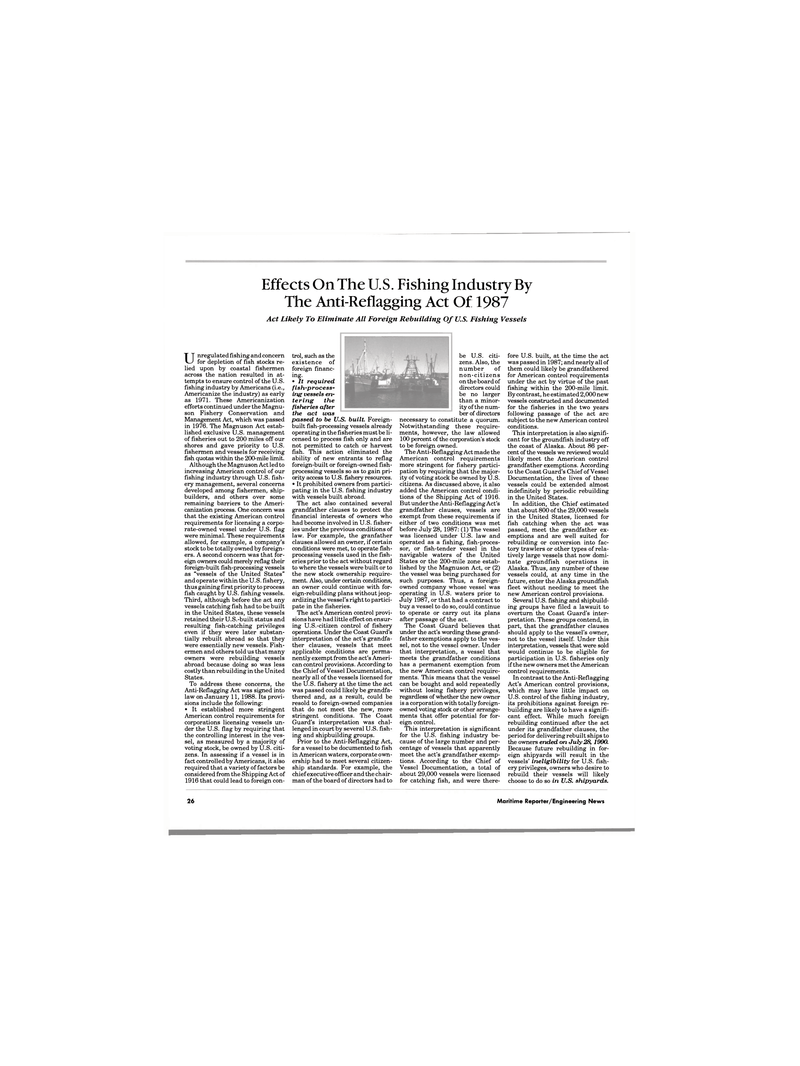
Page 25: of Maritime Reporter Magazine (March 1991)
Read this page in Pdf, Flash or Html5 edition of March 1991 Maritime Reporter Magazine
Effects On The U.S. Fishing Industry By
The Anti-Reflagging Act Of 1987
Act Likely To Eliminate All Foreign Rebuilding Of U.S. Fishing Vessels
Unregulated fishing and concern for depletion of fish stocks re- lied upon by coastal fishermen across the nation resulted in at- tempts to ensure control of the U.S. fishing industry by Americans (i.e.,
Americanize the industry) as early as 1971. These Americanization efforts continued under the Magnu- son Fishery Conservation and
Management Act, which was passed in 1976. The Magnuson Act estab- lished exclusive U.S. management of fisheries out to 200 miles off our shores and gave priority to U.S. fishermen and vessels for receiving fish quotas within the 200-mile limit.
Although the Magnuson Act led to increasing American control of our fishing industry through U.S. fish- ery management, several concerns developed among fishermen, ship- builders, and others over some remaining barriers to the Ameri- canization process. One concern was that the existing American control requirements for licensing a corpo- rate-owned vessel under U.S. flag were minimal. These requirements allowed, for example, a company's stock to be totally owned by foreign- ers. A second concern was that for- eign owners could merely reflag their foreign-built fish-processing vessels as "vessels of the United States" and operate within the U.S. fishery, thus gaining first priority to process fish caught by U.S. fishing vessels.
Third, although before the act any vessels catching fish had to be built in the United States, these vessels retained their U.S.-built status and resulting fish-catching privileges even if they were later substan- tially rebuilt abroad so that they were essentially new vessels. Fish- ermen and others told us that many owners were rebuilding vessels abroad because doing so was less costly than rebuilding in the United
States.
To address these concerns, the
Anti-Reflagging Act was signed into law on January 11, 1988. Its provi- sions include the following: • It established more stringent
American control requirements for corporations licensing vessels un- der the U.S. flag by requiring that the controlling interest in the ves- sel, as measured by a majority of voting stock, be owned by U.S. citi- zens. In assessing if a vessel is in fact controlled by Americans, it also required that a variety of factors be considered from the Shipping Act of 1916 that could lead to foreign con- trol, such as the existence of foreign financ- ing. • It required fish-process- ing vessels en- tering the fisheries after the act was passed to be U.S. built. Foreign- built fish-processing vessels already operating in the fisheries must be li- censed to process fish only and are not permitted to catch or harvest fish. This action eliminated the ability of new entrants to reflag foreign-built or foreign-owned fish- processing vessels so as to gain pri- ority access to U.S. fishery resources. • It prohibited owners from partici- pating in the U.S. fishing industry with vessels built abroad.
The act also contained several grandfather clauses to protect the financial interests of owners who had become involved in U.S. fisher- ies under the previous conditions of law. For example, the granfather clauses allowed an owner, if certain conditions were met, to operate fish- processing vessels used in the fish- eries prior to the act without regard to where the vessels were built or to the new stock ownership require- ment. Also, under certain conditions, an owner could continue with for- eign-rebuilding plans without jeop- ardizing the vessel's right to partici- pate in the fisheries.
The act's American control provi- sions have had little effect on ensur- ing U.S.-citizen control of fishery operations. Under the Coast Guard's interpretation of the act's grandfa- ther clauses, vessels that meet applicable conditions are perma- nently exempt from the act's Ameri- can control provisions. According to the Chief of Vessel Documentation, nearly all of the vessels licensed for the U.S. fishery at the time the act was passed could likely be grandfa- thered and, as a result, could be resold to foreign-owned companies that do not meet the new, more stringent conditions. The Coast
Guard's interpretation was chal- lenged in court by several U.S. fish- ing and shipbuilding groups.
Prior to the Anti-Reflagging Act, for a vessel to be documented to fish in American waters, corporate own- ership had to meet several citizen- ship standards. For example, the chief executive officer and the chair- man of the board of directors had to be U.S. citi- zens. Also, the number of non-citizens on the board of directors could be no larger than a minor- ity of the num- ber of directors necessary to constitute a quorum.
Notwithstanding these require- ments, however, the law allowed 100 percent of the corporation's stock to be foreign owned.
The Anti-Reflagging Act made the
American control requirements more stringent for fishery partici- pation by requiring that the major- ity of voting stock be owned by U.S. citizens. As discussed above, it also added the American control condi- tions of the Shipping Act of 1916.
But under the Anti-Reflagging Act's grandfather clauses, vessels are exempt from these requirements if either of two conditions was met before July 28, 1987: (1) The vessel was licensed under U.S. law and operated as a fishing, fish-proces- sor, or fish-tender vessel in the navigable waters of the United
States or the 200-mile zone estab- lished by the Magnuson Act, or (2) the vessel was being purchased for such purposes. Thus, a foreign- owned company whose vessel was operating in U.S. waters prior to
July 1987, or that had a contract to buy a vessel to do so, could continue to operate or carry out its plans after passage of the act.
The Coast Guard believes that under the act's wording these grand- father exemptions apply to the ves- sel, not to the vessel owner. Under that interpretation, a vessel that meets the grandfather conditions has a permanent exemption from the new American control require- ments. This means that the vessel can be bought and sold repeatedly without losing fishery privileges, regardless of whether the new owner is a corporation with totally foreign- owned voting stock or other arrange- ments that offer potential for for- eign control.
This interpretation is significant for the U.S. fishing industry be- cause of the large number and per- centage of vessels that apparently meet the act's grandfather exemp- tions. According to the Chief of
Vessel Documentation, a total of about 29,000 vessels were licensed for catching fish, and were there- fore U.S. built, at the time the act was passed in 1987; and nearly all of them could likely be grandfathered for American control requirements under the act by virtue of the past fishing within the 200-mile limit.
By contrast, he estimated 2,000 new vessels constructed and documented for the fisheries in the two years following passage of the act are subject to the new American control conditions.
This interpretation is also signifi- cant for the groundfish industry off the coast of Alaska. About 86 per- cent of the vessels we reviewed would likely meet the American control grandfather exemptions. According to the Coast Guard's Chief of Vessel
Documentation, the lives of these vessels could be extended almost indefinitely by periodic rebuilding in the United States.
In addition, the Chief estimated that about 800 of the 29,000 vessels in the United States, licensed for fish catching when the act was passed, meet the grandfather ex- emptions and are well suited for rebuilding or conversion into fac- tory trawlers or other types of rela- tively large vessels that now domi- nate groundfish operations in
Alaska. Thus, any number of these vessels could, at any time in the future, enter the Alaska groundfish fleet without needing to meet the new American control provisions.
Several U.S. fishing and shipbuild- ing groups have filed a lawsuit to overturn the Coast Guard's inter- pretation. These groups contend, in part, that the grandfather clauses should apply to the vessel's owner, not to the vessel itself. Under this interpretation, vessels that were sold would continue to be eligible for participation in U.S. fisheries only if the new owners met the American control requirements.
In contrast to the Anti-Reflagging
Act's American control provisions, which may have little impact on
U.S. control of the fishing industry, its prohibitions against foreign re- building are likely to have a signifi- cant effect. While much foreign rebuilding continued after the act under its grandfather clauses, the period for delivering rebuilt ships to the owners ended on July28, 1990.
Because future rebuilding in for- eign shipyards will result in the vessels' ineligibility for U.S. fish- ery privileges, owners who desire to rebuild their vessels will likely choose to do so in U.S. shipyards. 26 Maritime Reporter/Engineering News

 24
24

 26
26
